Sweet Corn
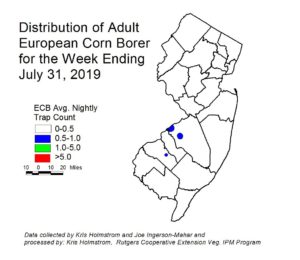 European corn borer (ECB) moth captures have increased slightly in parts of the southern half of the state (see ECB map at left). Thus far, the second flight appears to be very weak, as is consistent with recent years’ second flights. Limited feeding has appeared in whorl and pre-tassel corn.
European corn borer (ECB) moth captures have increased slightly in parts of the southern half of the state (see ECB map at left). Thus far, the second flight appears to be very weak, as is consistent with recent years’ second flights. Limited feeding has appeared in whorl and pre-tassel corn.
Growers should continue to scout whorl and pre-tassel stage plantings weekly and consider treating when infested plants exceed 12% in a 50 plant sample. As plantings proceed to the pre-tassel stage, ECB larvae may be found in emerging tassels. It is a good idea to treat individual plantings as they move into the full tassel/first silk stage one time. This eliminates any ECB larvae that have emerged with the tassels as they begin to move down the stalk to re-enter near developing ears.
Useful insecticides for this particular application include synthetic pyrethroids (IRAC Grp 3), spinosyns (including OMRI approved Entrust) IRAC Grp 5), and diamides such as Coragen (IRAC Grp 28) or materials such as Besiege which include the active ingredient in Coragen. Synthetic pyrethroids alone should NOT be used for corn earworm (CEW) protection on silking corn. Control with these materials is very inconsistent.
The highest nightly black light trap catches of ECB for the week ending 7/31/19 are as follows:
| Chester 1 | Hillsborough 1 | Sergeantsville 1 |
| Cinnaminson 1 | Medford 1 | Sparta 1 |
| Downer 1 | Milltown 1 | Tabernacle 1 |
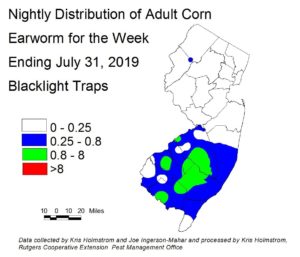 Corn earworm (CEW) moth catches have increased somewhat in blacklight traps in the southern half of the state, while pheromone traps have remained fairly steady with the exception of Cape May County, where a significant increase occurred (see blacklight map at left, and pheromone trap map below at right). Some coastal trap catches from states to our south are showing signs of increase, but overall, catches remain highly variable. While none of these catches indicate that a large scale migratory influx is underway, the trend has been gradual increase with scattered hot-spots. Red areas on the on the pheromone trap map indicate a 3-day silk spray schedule, while green
Corn earworm (CEW) moth catches have increased somewhat in blacklight traps in the southern half of the state, while pheromone traps have remained fairly steady with the exception of Cape May County, where a significant increase occurred (see blacklight map at left, and pheromone trap map below at right). Some coastal trap catches from states to our south are showing signs of increase, but overall, catches remain highly variable. While none of these catches indicate that a large scale migratory influx is underway, the trend has been gradual increase with scattered hot-spots. Red areas on the on the pheromone trap map indicate a 3-day silk spray schedule, while green 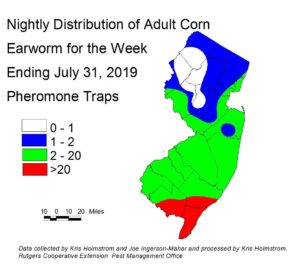 indicates a 4-5 day silk spray schedule. Blue areas represent a 5-6 day schedule, and white areas are 6-7 day. There are far fewer CEW pheromone traps than blacklights, and the resulting map has much broader color bands as a result. It should also be noted that the pheromone traps are much more sensitive than blacklights. Therefore, the number of moths caught in pheromone traps required to generate a specific spray interval is much higher than the number caught in blacklight traps. It must be stressed that there is high variability in these catches, and growers should consult with their IPM practitioner on recommended spray schedules.
indicates a 4-5 day silk spray schedule. Blue areas represent a 5-6 day schedule, and white areas are 6-7 day. There are far fewer CEW pheromone traps than blacklights, and the resulting map has much broader color bands as a result. It should also be noted that the pheromone traps are much more sensitive than blacklights. Therefore, the number of moths caught in pheromone traps required to generate a specific spray interval is much higher than the number caught in blacklight traps. It must be stressed that there is high variability in these catches, and growers should consult with their IPM practitioner on recommended spray schedules.
The highest nightly CEW pheromone trap catches for the week ending 7/31/19 are as follows:
| Green Creek 71 | East Vineland 17 | Jobstown 7 | Crosswicks 5 |
| Eldora 48 | Pedricktown 15 | Springdale 6 | Matawan 4 |
| Cedarville 27 | Berlin 7 | Woodstown 6 | Snyder Farm 4 |
Fall Armyworm
Fall armyworm (FAW) feeding has faded out in the limited areas where it had been discovered over the past 3 weeks. While we are entering the time of the season when FAW usually begins to increase, it is noteworthy just how little feeding has occurred thus far. Despite low activity, growers should scout all fields from pre-tassel stage down to early whorl stage. This pest causes extensive foliar damage on whorl stage corn (see photo at left), can also infest ears, and is capable of killing small plants. FAW larvae are brown in color (see photo at right), with an inverted
at left), can also infest ears, and is capable of killing small plants. FAW larvae are brown in color (see photo at right), with an inverted 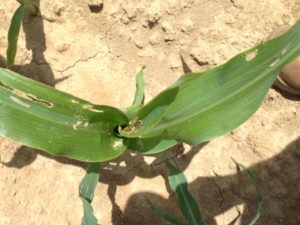 “Y” pattern on their head capsule. They are much larger than ECB when fully developed. FAW is even more consistently resistant to pyrethroid insecticides. For this reason, the same insecticides classes now recommended for CEW control should be utilized for FAW management.
“Y” pattern on their head capsule. They are much larger than ECB when fully developed. FAW is even more consistently resistant to pyrethroid insecticides. For this reason, the same insecticides classes now recommended for CEW control should be utilized for FAW management.
Silking Spray Schedules*:
South – 3-4 days
Central – 4-5 days
North – 5-6 days
*These recommendations are based on regional catches. Adhere to tighter spray schedules if indicated by local trap catches. To repeat: Synthetic pyrethroids alone should NOT be used for corn earworm (CEW) protection on silking corn, or for fall armyworm (FAW) management at any stage. Control with these materials is very inconsistent.
Tomatoes
 Several occurrences of southern blight have been discovered in the state recently. This disease is more prevalent in the lower mid-Atlantic states and is favored by warm wet conditions. Southern blight causes plants to wilt in a manner similar to timber rot. In this case, the organism produces many small, spherical sclerotia (see photo at left). Once discovered, if the infection is limited, it may be useful to remove plants from the field to prevent sclerotia from becoming inoculum for the following season. A fact sheet entitled Southern Blight of Tomato and Pepper from NC State Extension has useful information about this disease and it’s management.
Several occurrences of southern blight have been discovered in the state recently. This disease is more prevalent in the lower mid-Atlantic states and is favored by warm wet conditions. Southern blight causes plants to wilt in a manner similar to timber rot. In this case, the organism produces many small, spherical sclerotia (see photo at left). Once discovered, if the infection is limited, it may be useful to remove plants from the field to prevent sclerotia from becoming inoculum for the following season. A fact sheet entitled Southern Blight of Tomato and Pepper from NC State Extension has useful information about this disease and it’s management.
Peppers
As yet, no pepper weevils have been captured on traps placed near southern NJ pepper fields.
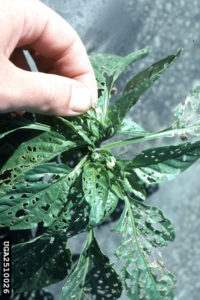 Pheromone traps established for beet armyworm (BAW) in the southern counties continue catching adults, with a significant increase in the Woodstown area, now at 79 BAW/night. Other catches include Folsom (7) and East Vineland (5) and Pedricktown (3). Additionally, there have been reports of low level injury in pepper fields in the Pedricktown and Folsom areas. This pest can reach levels that result in damage to pepper plants, although this does not occur each year. Growers in the southern counties should be alert for the appearance of severely defoliated terminals (see photo at left) on pepper plants. Small BAW larvae feed on these leaves before turning to fruit as they increase in size. As with FAW, beet armyworm is resistant to pyrethroid insecticides. Insecticides now recommended for CEW and FAW control are useful for BAW management.
Pheromone traps established for beet armyworm (BAW) in the southern counties continue catching adults, with a significant increase in the Woodstown area, now at 79 BAW/night. Other catches include Folsom (7) and East Vineland (5) and Pedricktown (3). Additionally, there have been reports of low level injury in pepper fields in the Pedricktown and Folsom areas. This pest can reach levels that result in damage to pepper plants, although this does not occur each year. Growers in the southern counties should be alert for the appearance of severely defoliated terminals (see photo at left) on pepper plants. Small BAW larvae feed on these leaves before turning to fruit as they increase in size. As with FAW, beet armyworm is resistant to pyrethroid insecticides. Insecticides now recommended for CEW and FAW control are useful for BAW management.
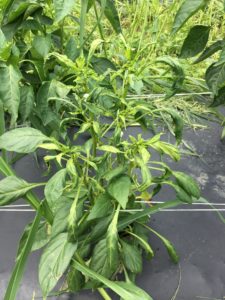 In the northern counties, several cyclamen mite infestations have been observed. These mites are too small to be seen without a microscope, and their presence is detected by their characteristic injury to foliage and fruit. Typically, clusters of plants begin to show distortion o
In the northern counties, several cyclamen mite infestations have been observed. These mites are too small to be seen without a microscope, and their presence is detected by their characteristic injury to foliage and fruit. Typically, clusters of plants begin to show distortion o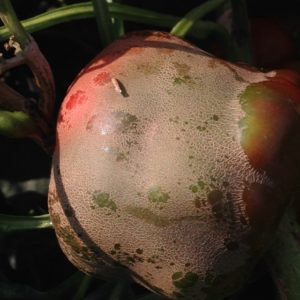 n new growth (see photo at left), while older, fully expanded leaves remain normal. As mites feed in blossoms, developing fruit exhibit extensive zippers and may even be fully russetted (see photo at right). Miticides labeled for spider mites are effective against cyclamen mites. See the Pepper Section of the 2019 Commercial Vegetable Production Guide for suggested materials. Resumption of normal foliar growth is an indication that treatments have been successful.
n new growth (see photo at left), while older, fully expanded leaves remain normal. As mites feed in blossoms, developing fruit exhibit extensive zippers and may even be fully russetted (see photo at right). Miticides labeled for spider mites are effective against cyclamen mites. See the Pepper Section of the 2019 Commercial Vegetable Production Guide for suggested materials. Resumption of normal foliar growth is an indication that treatments have been successful.
Pumpkins and Winter Squash
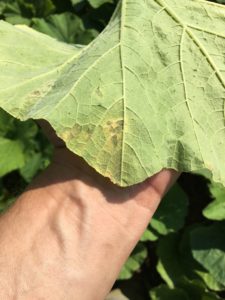 Note that cucurbit downy mildew (CDM) has now been discovered on cucumbers, pumpkins, acorn squash and butternut squash in numerous parts of the state. As of this Tuesday (7/30/19), CDM was detected on pumpkin and acorn squash in the sentinel plot at Snyder Farm in Hunterdon
Note that cucurbit downy mildew (CDM) has now been discovered on cucumbers, pumpkins, acorn squash and butternut squash in numerous parts of the state. As of this Tuesday (7/30/19), CDM was detected on pumpkin and acorn squash in the sentinel plot at Snyder Farm in Hunterdon 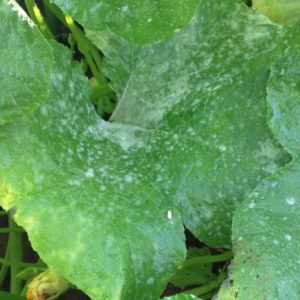 County, on butternut in a nearby commercial field, and on pumpkins in the Warren/Sussex border area. All growers should be applying appropriate fungicides for downy mildew on all cucurbit crops at this time. For regional information on this important disease, see the Cucurbit Downy Mildew Forecast webpage: http://cdm.ipmpipe.org/. In addition, many pumpkin fields are now beginning to set fruit, and powdery mildew (see photo at right) thresholds (2 lesions/50 older leaves) are being exceeded. Growers should include materials in their spray program that target powdery mildew as well. See the Pumpkin and Winter Squash section of the 2019 Commercial Vegetable Production Guide for suggested materials
County, on butternut in a nearby commercial field, and on pumpkins in the Warren/Sussex border area. All growers should be applying appropriate fungicides for downy mildew on all cucurbit crops at this time. For regional information on this important disease, see the Cucurbit Downy Mildew Forecast webpage: http://cdm.ipmpipe.org/. In addition, many pumpkin fields are now beginning to set fruit, and powdery mildew (see photo at right) thresholds (2 lesions/50 older leaves) are being exceeded. Growers should include materials in their spray program that target powdery mildew as well. See the Pumpkin and Winter Squash section of the 2019 Commercial Vegetable Production Guide for suggested materials
Brown Marmorated Stink Bug (BMSB)
 BMSB numbers in blacklight traps have shifted southward over the past week (see BMSB map at left). Although catches are not particularly high in light traps, we have captured enough BMSB to generate a map image. While this pest has generally declined as a threat to peppers, it remains a significant threat to tree fruit.
BMSB numbers in blacklight traps have shifted southward over the past week (see BMSB map at left). Although catches are not particularly high in light traps, we have captured enough BMSB to generate a map image. While this pest has generally declined as a threat to peppers, it remains a significant threat to tree fruit.
The highest nightly catches of BMSB in black light traps for the week ending 7/31/19 are as follows:
| Centerton 5 | Elm 2 | Hillsborough 1 |
| Green Creek 5 | Downer 2 | Jobstown 1 |
| Cinnaminson 3 | Matawan 2 | Medford 1 |
| East Vineland 3 | Crosswicks 1 | Princeton 1 |

